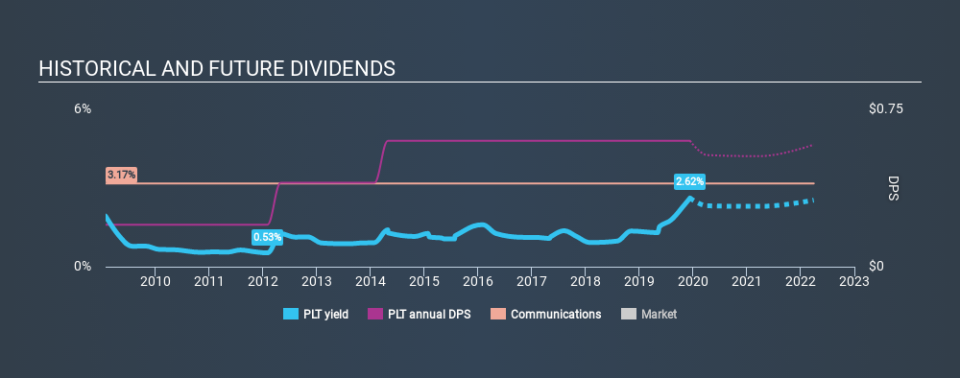Would Plantronics, Inc. (NYSE:PLT) Be Valuable To Income Investors?

Could Plantronics, Inc. (NYSE:PLT) be an attractive dividend share to own for the long haul? Investors are often drawn to strong companies with the idea of reinvesting the dividends. Yet sometimes, investors buy a popular dividend stock because of its yield, and then lose money if the company's dividend doesn't live up to expectations.
While Plantronics's 2.6% dividend yield is not the highest, we think its lengthy payment history is quite interesting. The company also bought back stock equivalent to around 1.8% of market capitalisation this year. Remember though, given the recent drop in its share price, Plantronics's yield will look higher, even though the market may now be expecting a decline in its long-term prospects. There are a few simple ways to reduce the risks of buying Plantronics for its dividend, and we'll go through these below.
Explore this interactive chart for our latest analysis on Plantronics!
Payout ratios
Companies (usually) pay dividends out of their earnings. If a company is paying more than it earns, the dividend might have to be cut. Comparing dividend payments to a company's net profit after tax is a simple way of reality-checking whether a dividend is sustainable. Although Plantronics pays a dividend, it was loss-making during the past year. When a company recently reported a loss, we should investigate if its cash flows covered the dividend.
Of the free cash flow it generated last year, Plantronics paid out 49% as dividends, suggesting the dividend is affordable.
Is Plantronics's Balance Sheet Risky?
Given Plantronics is paying a dividend but reported a loss over the past year, we need to check its balance sheet for signs of financial distress. A quick check of its financial situation can be done with two ratios: net debt divided by EBITDA (earnings before interest, tax, depreciation and amortisation), and net interest cover. Net debt to EBITDA is a measure of a company's total debt. Net interest cover measures the ability to meet interest payments. Essentially we check that a) the company does not have too much debt, and b) that it can afford to pay the interest. With net debt of 4.95 times its EBITDA, investors are starting to take on a meaningful amount of risk, should the business enter a downturn.
We calculated its interest cover by measuring its earnings before interest and tax (EBIT), and dividing this by the company's net interest expense. With EBIT of less than 1 times its interest expense, Plantronics's financial situation is potentially quite concerning. Readers should investigate whether it might be at risk of breaching the minimum requirements on its loans.
Remember, you can always get a snapshot of Plantronics's latest financial position, by checking our visualisation of its financial health.
Dividend Volatility
From the perspective of an income investor who wants to earn dividends for many years, there is not much point buying a stock if its dividend is regularly cut or is not reliable. Plantronics has been paying dividends for a long time, but for the purpose of this analysis, we only examine the past 10 years of payments. The dividend has been stable over the past 10 years, which is great. We think this could suggest some resilience to the business and its dividends. During the past ten-year period, the first annual payment was US$0.20 in 2009, compared to US$0.60 last year. Dividends per share have grown at approximately 12% per year over this time.
It's rare to find a company that has grown its dividends rapidly over ten years and not had any notable cuts, but Plantronics has done it, which we really like.
Dividend Growth Potential
Dividend payments have been consistent over the past few years, but we should always check if earnings per share (EPS) are growing, as this will help maintain the purchasing power of the dividend. Plantronics's earnings per share have shrunk at 61% a year over the past five years. A sharp decline in earnings per share is not great from from a dividend perspective, as even conservative payout ratios can come under pressure if earnings fall far enough.
Conclusion
To summarise, shareholders should always check that Plantronics's dividends are affordable, that its dividend payments are relatively stable, and that it has decent prospects for growing its earnings and dividend. We're not keen on the fact that Plantronics paid dividends despite reporting a loss over the past year, although fortunately its dividend was covered by cash flow. It's not great to see earnings per share shrinking. The dividends have been relatively consistent, but we wonder for how much longer this will be true. In sum, we find it hard to get excited about Plantronics from a dividend perspective. It's not that we think it's a bad business; just that there are other companies that perform better on these criteria.
Given that earnings are not growing, the dividend does not look nearly so attractive. Businesses can change though, and we think it would make sense to see what analysts are forecasting for the company.
If you are a dividend investor, you might also want to look at our curated list of dividend stocks yielding above 3%.
If you spot an error that warrants correction, please contact the editor at editorial-team@simplywallst.com. This article by Simply Wall St is general in nature. It does not constitute a recommendation to buy or sell any stock, and does not take account of your objectives, or your financial situation. Simply Wall St has no position in the stocks mentioned.
We aim to bring you long-term focused research analysis driven by fundamental data. Note that our analysis may not factor in the latest price-sensitive company announcements or qualitative material. Thank you for reading.

 Yahoo Finance
Yahoo Finance 
